Whether you’re upgrading your office conference room or crafting the ultimate home theater, a high-quality projector screen is a key part of your toolkit. But what exactly should you be looking for in a projector screen? Understanding your options is the first step in choosing the right screen for the job.
This blog article will help you make the right choice. When finished, check out the wide selection of screens Comprehensive offers at www.comprehensiveco.com/screens
Step 1: Projector Screen Type
The first step to choosing the right Projector Screen that best suits your particular needs or application, is to choose the type of screen you wish to use. From the mounting style to the method of the screens retraction, you’ll want to take everything into consideration when choosing your screen type. The permanency of your screen and the type of functionality or retraction method you’d like your screen to have are two of the most important things to consider.
Below are brief descriptions and examples of each screen type:
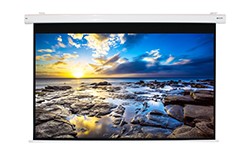 Electric Motorized Projector Screens are ideal for applications which require a wall or ceiling mounted installation, with a sleek, modern and flexible projection solution that doesn’t hinder the usability of a room. The perfect choice for today’s high definition home theater systems, conference rooms and classrooms. Screens range from 84″ to 150″ diagonal sizes.
Electric Motorized Projector Screens are ideal for applications which require a wall or ceiling mounted installation, with a sleek, modern and flexible projection solution that doesn’t hinder the usability of a room. The perfect choice for today’s high definition home theater systems, conference rooms and classrooms. Screens range from 84″ to 150″ diagonal sizes.
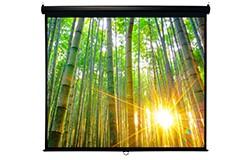 Manual pull down wall or ceiling mounted Projector Screens are a great alternative to electric projector screens, at a fraction of the cost. Simple and reliable, these screens offer a rugged and efficient projection solution for rigorous daily use, at an affordable price. Perfect for classrooms, conference rooms and inexpensive home theater systems. Screens range from 71″ to 170″ diagonal sizes.
Manual pull down wall or ceiling mounted Projector Screens are a great alternative to electric projector screens, at a fraction of the cost. Simple and reliable, these screens offer a rugged and efficient projection solution for rigorous daily use, at an affordable price. Perfect for classrooms, conference rooms and inexpensive home theater systems. Screens range from 71″ to 170″ diagonal sizes.
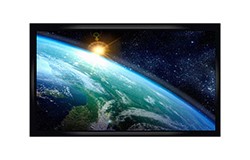 Fixed Frame Projector Screens are one the best choices for home theater, thanks to their high performance matte white fabric and outstanding optical performance. Fixed frame screens also complement any situation where a permanent wall-mounted solution is preferred – such as an auditorium, conference room, or in a house of worship. These screens generally require more assembly than other screen types, however they are more easily wall-mounted (simply hanging like a picture frame on the included brackets), requiring less installation and no electrical connectivity. Screens range from 100″ to 150″ diagonal sizes.
Fixed Frame Projector Screens are one the best choices for home theater, thanks to their high performance matte white fabric and outstanding optical performance. Fixed frame screens also complement any situation where a permanent wall-mounted solution is preferred – such as an auditorium, conference room, or in a house of worship. These screens generally require more assembly than other screen types, however they are more easily wall-mounted (simply hanging like a picture frame on the included brackets), requiring less installation and no electrical connectivity. Screens range from 100″ to 150″ diagonal sizes.
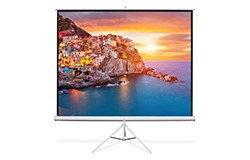 Tripod Projector Screens are the ideal portable budget solution for mobile presentations! Rugged and easily setup in minutes, these screens are a very versatile solution for any of your projection needs. Perfect for classrooms, training rooms, trade shows and even limited outdoor use. Screens range from 71″ to 135″ diagonal sizes.
Tripod Projector Screens are the ideal portable budget solution for mobile presentations! Rugged and easily setup in minutes, these screens are a very versatile solution for any of your projection needs. Perfect for classrooms, training rooms, trade shows and even limited outdoor use. Screens range from 71″ to 135″ diagonal sizes.
Floor Rising Projector Screens
 Floor Rising Portable Projector Screens are the perfect companion for business presentations, trade shows, hospitality, a simple home theater or any portable application! Less affordable than a traditional Tripod Screen, the Floor Rising Screen does however have a few more benefits – easier to carry, easier to set up and easier to retract. Screens range from 60″ to 100″ diagonal sizes.
Floor Rising Portable Projector Screens are the perfect companion for business presentations, trade shows, hospitality, a simple home theater or any portable application! Less affordable than a traditional Tripod Screen, the Floor Rising Screen does however have a few more benefits – easier to carry, easier to set up and easier to retract. Screens range from 60″ to 100″ diagonal sizes.
 Tabletop Projector Screens are the smallest, most compact projector screen. Perfect for on-the-go presentations, small conference rooms or even video gaming. These screens are small enough to easily fit a media console or conference table for a quick mobile presentation. Screens range from 30″ to 50″ diagonal sizes.
Tabletop Projector Screens are the smallest, most compact projector screen. Perfect for on-the-go presentations, small conference rooms or even video gaming. These screens are small enough to easily fit a media console or conference table for a quick mobile presentation. Screens range from 30″ to 50″ diagonal sizes.
Folding Frame Projector Screens
 Folding Frame Portable Projector Screens are specifically designed for large venue events, delivering larger-than-life presentations anytime and anywhere! Ideal for trade shows, auditoriums, stages and even outdoors, these screens are quick to set up and take down, assembling in just minutes without any tools. Screens range from 100″ to 165″ diagonal sizes.
Folding Frame Portable Projector Screens are specifically designed for large venue events, delivering larger-than-life presentations anytime and anywhere! Ideal for trade shows, auditoriums, stages and even outdoors, these screens are quick to set up and take down, assembling in just minutes without any tools. Screens range from 100″ to 165″ diagonal sizes.
Inflatable Outdoor Projector Screens
 Inflatable Outdoor Projector Screens transform your backyard, local park or campus into an instant outdoor movie theater. Combining the latest innovative product designs with the best materials, these screens are lightweight yet durable, easy to use and inflates in just seconds. Screens range from 10′ to 20′ wide sizes.
Inflatable Outdoor Projector Screens transform your backyard, local park or campus into an instant outdoor movie theater. Combining the latest innovative product designs with the best materials, these screens are lightweight yet durable, easy to use and inflates in just seconds. Screens range from 10′ to 20′ wide sizes.
Check out our huge selection of Projector Screens at www.comprehensiveco.com/screens
Step 2: Projector Screen Fabric
 After you’ve decided on the type and mechanism of your ideal screen, you’ll need to select the best projector screen fabric for the job. Different screen fabrics handle different applications and environments, their effectiveness depends on several factors, including the resolution of the media used, the lighting and acoustic conditions and the viewing angle of the audience. While this may seem like a complicated topic, understanding the purpose of screen fabric and the types available makes it easier to choose the optimal fabric for your application.
After you’ve decided on the type and mechanism of your ideal screen, you’ll need to select the best projector screen fabric for the job. Different screen fabrics handle different applications and environments, their effectiveness depends on several factors, including the resolution of the media used, the lighting and acoustic conditions and the viewing angle of the audience. While this may seem like a complicated topic, understanding the purpose of screen fabric and the types available makes it easier to choose the optimal fabric for your application.
The most important place to start when selecting a screen fabric, are with the Gain and Viewing Angle of the fabric. There is a lot to know about each and how they affect each other.
Understanding Gain
Gain is a measurement of a screen fabrics light reflectivity from the projection device, when the measurement is taken for light targeted and reflected perpendicular to the screen. A typical screen Gain of 1.0, means that all the light being directed at the screen is being reflected back with the same brightness.

Gain greater than 1.0 – Means that the projection screen fabric is increasing the brightness of the projected image back to the audience.
Application – Higher Gain screen fabrics are typically used in environments with higher ambient light, where the light cannot be adequately dimmed or controlled. For example: large auditoriums, convention centers or office building with windows. They are also used when a projector is not powerful enough to create the adequate amount of brightness for the environment.
Viewing Angle
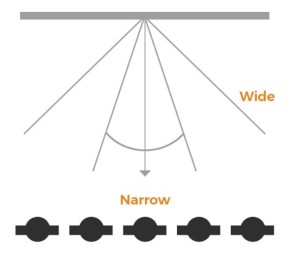 Viewing angle is a measurement of the distance from the center of the screen at which you can still see the same quality image as from the viewing axis.
Viewing angle is a measurement of the distance from the center of the screen at which you can still see the same quality image as from the viewing axis.
At Comprehensive, we strive to provide our customers with the most flexible and convenient solution for their needs. Which is why we construct all our screens using a Matte White fabric with a 1.0 – 1.1 Gain, with a wide 110° – 120° Viewing Angle. A 1.0 gain screen diffuses light evenly in all directions, so seating can be placed in a wide viewing angle relative to the screen and all seats will afford a similar viewing experience regardless of the angle of view. The ideal solution for almost all types of applications.
Step 3: Projector Screen Sizes
Once you’ve decided on the type of screen you are using and the type of fabric you want to use, selecting the size or aspect ratio of your screen should be next on the list of decisions to make. Some of the most popular sizes are Square, Video and HDTV format:
SQUARE 1:1
 Square format projector screens have a width to height ratio that is generally 1:1. Square screens are usually used for data presentations and overhead projectors, but the screen can be adjusted to fit Video 4:3 and HDTV 16:9.
Square format projector screens have a width to height ratio that is generally 1:1. Square screens are usually used for data presentations and overhead projectors, but the screen can be adjusted to fit Video 4:3 and HDTV 16:9.
VIDEO 4:3
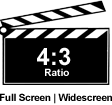 Video format projector screens have a width to height ratio of 4:3. The 4:3 ratio for standard television has been in use since television’s origins and many computer monitors use the same aspect ratio. Video Format screens are the best option if you’ll be switching equally between full-screen and widescreen viewing.
Video format projector screens have a width to height ratio of 4:3. The 4:3 ratio for standard television has been in use since television’s origins and many computer monitors use the same aspect ratio. Video Format screens are the best option if you’ll be switching equally between full-screen and widescreen viewing.
HDTV 16:9
 HDTV format projector screens have a width to height ratio of 16:9. HDTV screens the optimal format for home theater, offering the best matched fit for widescreen viewing and is the international standard format of HDTV. Wider options include Letterbox and Widescreen; not all but a few of our screens are available in these sizes.
HDTV format projector screens have a width to height ratio of 16:9. HDTV screens the optimal format for home theater, offering the best matched fit for widescreen viewing and is the international standard format of HDTV. Wider options include Letterbox and Widescreen; not all but a few of our screens are available in these sizes.
Once you’ve followed these basic steps, you should be able to understand and identify what you need in a projector screen. However, this guideline is simply a recommendation, a guideline to help you navigate the screen buying process. These steps will work well in most situations, but never be afraid to deviate from your path. It’s always more important to consider your personal needs based on your situation.
If you’re ready to get started ordering your new projector screen, visit us at www.comprehensiveco.com/screens or call 800.526.0242 to speak to a projection specialist.


I need a good but not too expensive Projector, Motorised Screen and Ceiling Mount for my Living Room, I love movies, soccer and intend to connect to DSTV and Blu-ray. Kindly advise, I have space to accommodate the screen.
LikeLike